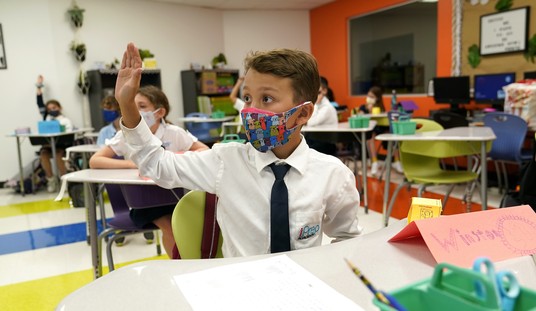On the third floor, employees gathering for a staff meeting chose to barricade themselves rather than flee into the hallway where they heard gunshots.
Capt. Mark Vandroff and his colleagues stacked chairs and desks in front of a door and got down on the floor. Two bullets care [sic] through the wall off the conference room, but high above their heads. The [sic] stayed in place for 30 minutes before police evacuated them.
“We were hunkered down, we were on the floor because we had heard the previous gunshot. We heard gunfire and we looked up and there were two bullet holes in the top of the wall of the conference room,” Vandroff said.
Rather than make noise by talking, his team texted each other from their smart phones.
By the time it was over, former Navy reservist Aaron Alexis had shot and killed twelve individuals at the Washington Navy Yard in Washington, D.C.
Commander Tim Jirus told Fox News: “For those of us who knew there was an active shooter because they were much closer to where that was happening at, there is shelter-in-place. You lock your door inside your building until someone tells you it’s clear.”
According to the Washington City Paper, “[Metropolitan Police Department] Chief Cathy Lanier said after the first shots were reported this morning, MPD officers were on the scene within two to three minutes, at which point security within Navy Yard had already engaged the shooter. Within seven minutes, Lanier says, an ‘active shooter team’ was in the building and had ‘multiple engagements’ with the shooter, the last of which resulted in his death.”
Bryan Preston noted that the Navy Yard, like all military bases, is a “gun free zone” thanks to a Clinton-era policy. Preston wrote, “In 1993, President Bill Clinton decreed that US military personnel were to surrender the Second Amendment rights that they swear an oath to support and defend.” So the employees at the 3000-person building were sitting ducks, unable to defend themselves against an active shooter.
There is something very unsettling about the mental image of Navy Yard employees — many of them active-duty soldiers of the most powerful military in the world — sheltered-in-place, “hunkered down” in a room waiting to be rescued by the Metropolitan Police Department. No doubt, many of these men and women are decorated war heroes who would have, had they been permitted to carry a sidearm, bravely taken out Aaron Alexis instead of sheltering-in-place. Instead, because the attack happened in a gun-free zone, they waited for the “authorities” to rescue them — hiding out behind stacks of office chairs, settling for a false sense of security behind barricaded doors with smart phones as their only weapons.
Sheltering-in-place in gun-free zones is this generation’s version of “duck-and-cover” drills. For those not old enough to remember, beginning in the 1950s and continuing throughout the Cold War years, the U.S. government told citizens they could protect themselves from the effects of a nuclear bomb — a bomb the Soviets could drop at any moment — by huddling under their desks or other furniture and covering the backs of their necks with their hands. School children practiced bomb drills in much the same way today’s kids practice lockdowns.
In my elementary school in the 1970s, we were warned against looking at the bright light of a nuclear blast and told our hands would protect us from the radiation. Once we were old enough to learn about the bombs dropped on Hiroshima and Nagasaki, we all knew the truth — that the drills did little more than give us a false sense of security. Sometime around sixth grade, kids started mocking the whole exercise. “This is stupid. We’ll all be vaporized instantly if a bomb drops out there,” was a typical mantra. We were all terrified at the thought, but completely powerless to protect ourselves in the event of a nuclear detonation.
http://youtu.be/u1MQ4eyg6U4
And so it is with the shelter-in-place orders and lockdowns behind desks and chairs. Unarmed citizens, stripped of their Second Amendment rights in gun-free zones, are powerless to protect themselves from an armed shooter. The best they can do is call the cops and wait for help to arrive. Duck-and-cover.
But unlike the perils faced during a nuclear attack, citizens in 2013 have the means to protect themselves from the threat of an active shooter: a good guy with a gun stopping a bad guy with a gun. Yet in gun-free zones, they’re forced to duck-and-cover rather than defend their lives and the lives of their co-workers. So we see decorated soldiers and other brave Americans hunkering down “until someone tells you it’s clear.” Moreover, Americans across the country now accept that shelter-in-place is the best we can hope for when under attack.
We can’t know whether a change in the gun-free zone policy would have changed the outcome of the Navy Yard shooting. But we do know that stripping citizens of their Second Amendment rights to protect themselves renders them as powerless as those school children attempting to shield themselves from a nuclear blast with their hands. Mostly, the shelter-in-place orders give the public a false sense of security in an attempt to perpetuate the delusion that a gun-free zone is the same as a violence-free zone. The truth is that the shooting rarely stops until a good guy shoots the bad guy — and a bad guy can amass a lot of carnage in the seven minutes it takes the Metropolitan Police Department to arrive.












Join the conversation as a VIP Member